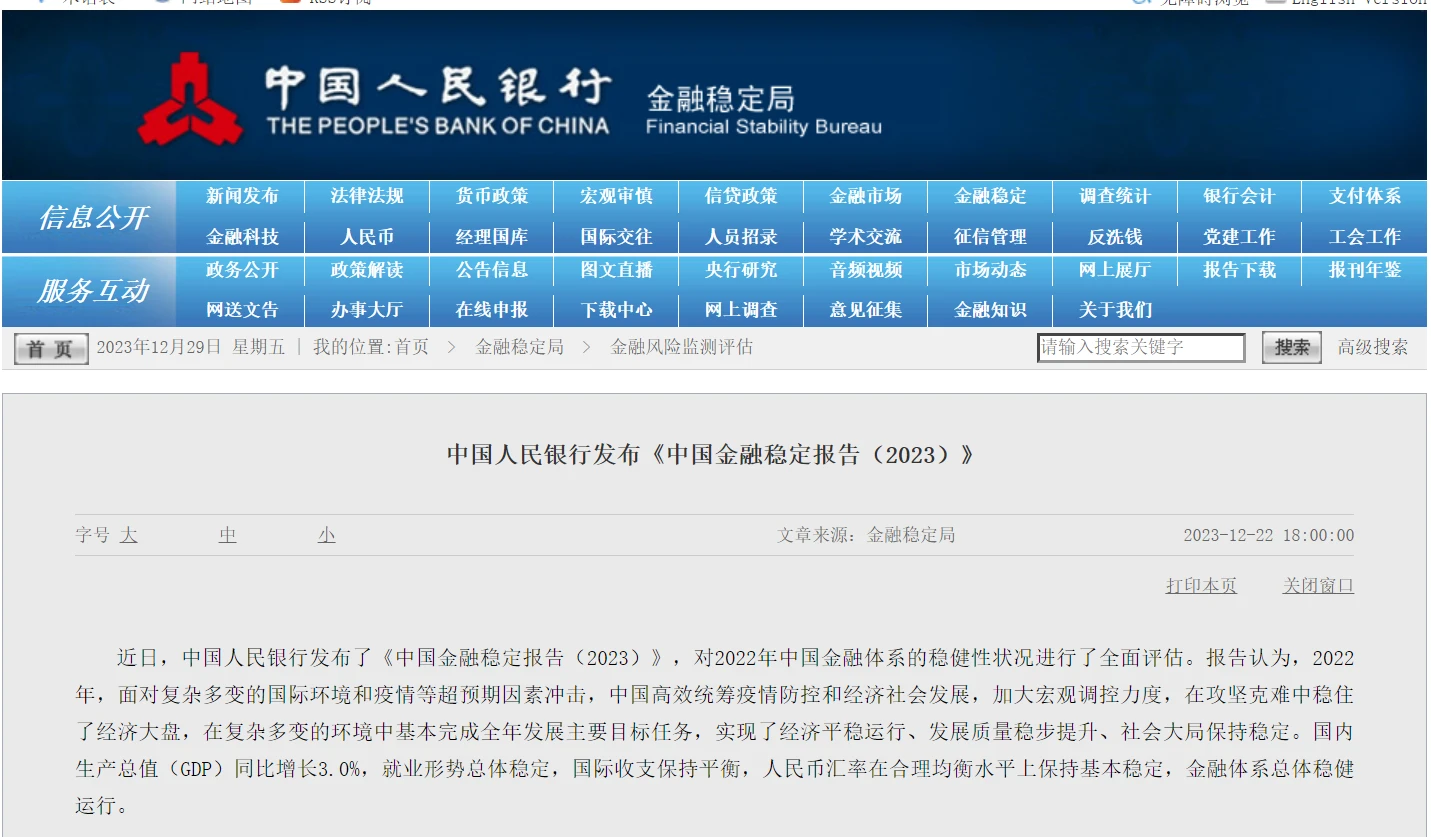Original author:DeThings reporter Wu Tianyi, Lawyer Liu Honglin, founder and director of Shanghai Mankiw Law Firm, reprinted with permission.
Recently, the Peoples Bank of China released the China Financial Stability Report (2023). The report mentioned that in 2022, global geopolitical conflicts continued, inflation in some major economies was at high levels, world economic and trade growth momentum weakened, financial markets continued to fluctuate, and external environment uncertainty increased. In the chapter on other industries and emerging risks, the report points out that crypto-assets have both financial and digital technology risks. Cryptoassets refer to private sector digital assets that mainly rely on cryptography, distributed ledgers or similar technologies for development and operation, creating new asset forms and business models.

Regarding the related crypto-asset issues mentioned in the report, lawyer Liu Honglin from Mankiw Law Firm said that the report highlighted the financial risks and technical risks of crypto-assets. Based on the above risks, the central bank has emphasized the supervision and prevention and control measures taken by the Chinese government in the crypto-asset industry in recent years, indicating that the central bank still maintains a relatively cautious attitude towards crypto-assets.
01 Cryptocurrency does not have the legal properties of currency
The report mentioned that crypto-assets are not issued by monetary authorities, do not have monetary attributes such as legality and compulsory nature, and are not subject to supervision commensurate with the nature of their business, thus presenting dual risks in finance and digital technology. Liu Honglin, a lawyer at Mankiw Law Firm, said that because crypto assets are not issued by an official central agency, they lack a legal regulatory framework similar to traditional currencies. Due to the lack of supervision and monetary policy intervention, price manipulation and fraud may occur. and insufficient investor protection. Secondly, due to the immaturity of the encrypted asset market and the lack of adequate security guarantees for the technology used, its prices fluctuate greatly, and there may be risks such as asset loss and theft.
Since encrypted assets are based on the decentralized technology of blockchain, it makes it difficult to trace the flow of funds, which makes it possible for them to be used for illegal purposes, such as money laundering, illegal transactions, etc. Liu Honglin said, Also because encrypted assets are not issued by a central organization, except for some mainstream virtual currencies, virtual assets lack widespread recognition and limit their ability to serve as an alternative currency.
In addition, Liu Honglin believes that CBDC is different from cryptocurrency. It is a legal currency in digital form issued by the central bank of the country. It has legal status and the central bank is responsible for supervision, issuance, clearing and other functions. This is the biggest difference from crypto-assets that are decentralized and do not have legal status. Based on their legal currency status, they are regulated by the country’s central bank. Generally speaking, they will maintain a relatively stable value, which is why most of them What crypto assets don’t have. In terms of security, due to the centralized issuance characteristics of CBDC, the central bank has a stronger ability to protect asset security. In terms of security, CBDC is higher than cryptocurrency.
02 Cryptocurrency poses risks of illegal financial activities
The report also mentioned that the risks of traditional unregulated illegal financial activities are reflected in the field of crypto assets, such as asset price bubbles, large price fluctuations, liquidity and maturity mismatches, high leverage, and procyclical risks.
Liu Honglin said: Traditional unregulated illegal financial activities mainly include, for example, illegally absorbing public deposits without approval from relevant competent authorities or absorbing public deposits in disguised form, illegally raising funds and illegally distributing funds to unspecified objects in society without approval in accordance with the law. Loans, settlements, bill discounts, fund lending, trust investments, financial leasing, financing guarantees, foreign exchange trading and other illegal financial activities.
At present, my countrys financial supervision mainly includes three aspects: management of market access of financial institutions; supervision and inspection of financial business activities; handling of problematic financial institutions and adoption of policies and measures to mitigate risks. In the context of my countrys strong financial supervision, a series of regulatory laws and regulations have been produced, such as the Peoples Bank of China Law, Commercial Bank Law, Invoice Law, Guarantee Law, Insurance Law, Securities Law, Trust Law, Securities Investment Fund Law, Banking Supervision Law, etc. Finally, my country’s Criminal Law provides the final supervision over relevant illegal activities.
On the other hand, the report mentioned that this field has also generated new risks related to digital technology, such as the lack of a negative feedback adjustment mechanism in automatically executed smart contracts, which is more likely to lead to a flash crash in the market; There are security vulnerabilities in the data interaction process, which can easily be attacked by hackers, leading to market manipulation and asset loss; the governance mechanism of decentralized finance (DeFi) essentially has centralized characteristics and is easily controlled by a few insiders, harming other investors. Benefits; The anonymity and difficulty in recovery of assets lead to anti-money laundering and anti-terrorist financing risks, etc.
Liu Honglin believes that crypto assets are difficult to be regulated because of their booming development in quantity and type, as well as their anonymity and decentralized trading characteristics, which make it difficult for traditional financial supervision methods to be applied in the field of crypto assets. Moreover, a huge generation gap has formed between the development speed of financial technology and the lagging cognition of regulators. This regulatory generation gap is very likely to cause regulatory theory, policy and the development of cryptocurrency to be in a state of misalignment for a long time. In addition, the emergence of anonymity-enhanced cryptocurrencies, privacy wallets and other products and services has reduced the transparency of crypto-assets and made funds more obscure, which promotes financial fraud, manipulation of the crypto market, and increases the difficulty of financial supervision.
03 Geopolitics affects financial markets
The report pointed out that in 2022, global geopolitical conflicts will continue, inflation in some major economies will be at high levels, world economic and trade growth momentum will weaken, financial markets will continue to fluctuate, and the external environment will become more uncertain. my country has earlier carried out clean-up and rectification of risks related to the crypto-asset field. Currently, the scale of crypto assets accounts for a small proportion of global financial assets and has limited connection with the traditional financial system. However, its rapid development, complex business model, opaque governance structure, and active cross-border business may threaten the stability of the global financial system. my country has earlier carried out clean-up and rectification in areas such as token issuance and financing, crypto-asset trading platforms, and issued the Notice on Further Preventing and Dealing with Speculation Risks in Virtual Currency Transactions in 2021, uniting multiple departments to form a joint effort to prevent, resolve, and deal with risks. , effectively curbing risks in related fields.
Liu Honglin mentioned that the China Financial Stability Report (2023), as an annual report issued by the Peoples Bank of China, aims to comprehensively assess the soundness of my countrys financial system. This report plays an important role in the industry. By assessing the stability of the financial system, it helps formulate policies, guide the use of structural monetary policy tools, accurately guide and increase support for key areas, so as to maintain the health and stability of the financial system. .
Liu Honglin believes that the report highlights the financial risks and technical risks of crypto assets. Financial risks come from crypto-assets issued by non-monetary authorities, which are not legally compensable, and because they are not subject to business-appropriate supervision, traditional financial risks will further expand in the crypto world. Technical risks mainly come from the risk of asset loss caused by smart contracts, data interaction, hacker attacks, etc.
Based on the above risks, the central bank has emphasized the supervision and prevention and control measures taken by the Chinese government in the crypto-asset industry in recent years, indicating that the central bank still maintains a relatively cautious attitude towards crypto-assets.
Special statement:
This article is an original article by Shanghai Mankiw Law Firm. It only represents the personal views of the author of this article and does not constitute legal consultation or legal opinions on specific matters. If you need to reprint the article, please contact Mankun Law Firm staff: MankunLawFirm










